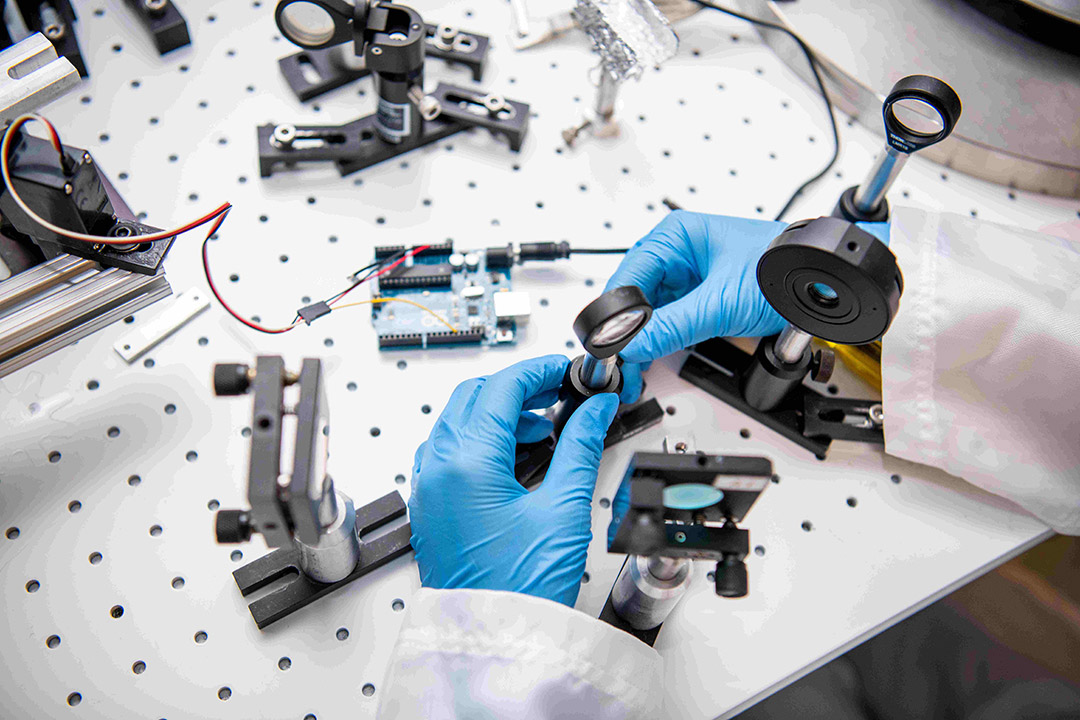RIT part of National Science Foundation grant to help spur next-generation lasers
Carlson Center for Imaging Science receives $170,000 in Phase 1 grant
Gabrielle Plucknette-DeVito
Preparing to test a liquid crystal light sail in an imaging science lab at RIT, which is working with a group of area higher-education and industry partners—led by the University of Rochester—on a Development Award grant project from the National Science Foundation to help boost the next generation of lasers.
Rochester Institute of Technology is among a group of area higher-education and industry partners sharing a $1 million Regional Innovation Engines Development Award grant from the National Science Foundation to help boost the next generation of lasers.
Susan Houde-Walter, professor and director of the Chester F. Carlson Center for Imaging Science in RIT’s College of Science, and co-principal investigator for the STELLAR Engine project, said RIT received nearly $170,000 for phase one of a proposal to develop advanced laser technology and help address the shortage of skilled workers in the critical field of laser products.
The project is bringing together a number of institutional and industrial business partners, led by the University of Rochester and including partners such as Monroe Community College and Luminate, a startup accelerator program of NextCorps.
According to Houde-Walter, RIT’s work during the project’s initial phase will include a pilot project with interdisciplinary faculty, undergraduates, and graduate students working with local high students and teachers over the next two summers to begin introducing them to STEM careers like those in imaging science and laser technologies.
“Both laser products and the workforce needed to build and use them are critical to many manufacturing, communications, defense, and security systems,” Houde-Walter said. “Yet both core laser innovation and the manufacturing and packaging of lasers are increasingly carried out overseas, and very few U.S. residents get trained in laser science and technology.”
By working with faculty and students from RIT colleges and the Center for Imaging Science, “these high school students will receive valuable experience and exposure to what it means to work in these critical fields and give them the opportunity to picture themselves in a STEM career,” she noted.
In addition to learning how to communicate technical concepts while working on research programs, high school students will visit RIT’s Microsystems Lab, the UR’s laser lab, and local companies working in the laser industry.
Given its deep roots in optics and laser technology, the Rochester region is well-positioned to help educators develop curricula that will enable students to learn skilled trades in laser systems, Houde-Walter observed.
The STELLAR—short for Science, Technology and Engineering of Lasers and Laser Applications Research—Engine project will build upon this to create a self-sustaining ecosystem for laser-based technologies by combining investments in R&D, infrastructure, workforce development, and entrepreneurship in a way that attracts startup companies and encourages the growth of established companies in the area.
The project is intended to create a manufacturing ecosystem for lasers, with the ultimate goal of making the U.S. competitive again globally in this important field.
The NSF Engines program is designed to be a transformational investment for the nation, ensuring the U.S. remains in the vanguard of competitiveness for decades to come.
“These NSF Engines Development Awards lay the foundation for emerging hubs of innovation and potential future NSF Engines,” said NSF Director Sethuraman Panchanathan. “These awardees are part of the fabric of NSF’s vision to create opportunities everywhere and enable innovation anywhere. They will build robust regional partnerships rooted in scientific and technological innovation in every part of our nation.”
“Through these planning awards, NSF is seeding the future for in-place innovation in communities and to grow their regional economies through research and partnerships,” Panchanathan added. “This will unleash ideas, talent, pathways, and resources to create vibrant innovation ecosystems all across our nation.”
The awardees span a broad range of states and regions, reaching geographic areas that have not fully benefited from the technology boom of the past decades.
Launched by NSF’s new Directorate for Technology, Innovation and Partnerships and authorized by the “CHIPS and Science Act of 2022,” the NSF Engines program uniquely harnesses the nation’s science and technology research and development enterprise and regional-level resources. NSF Engines aspire to catalyze robust partnerships to positively impact regional economies, accelerate technology development, address societal challenges, advance national competitiveness, and create local, high-wage jobs.
More information can be found on the NSF Engines program website.








